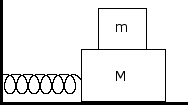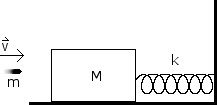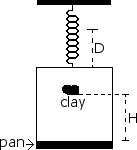Physics 1: Simple Harmonic Motion
An oscillator consists of a block of mass 0.500 kg connected to a spring. When set into oscillation with amplitude 35.0 cm, the oscillator repeates its motion every 0.500 s. Find the:
A. period
B. frequency
C. angular frequency
D. spring constant
E. maximum speed
F. magnitude of maximum force on the block from the spring
An oscillator consists of a block attached to a spring( k = 400 N/m). At some time t, the position (measured from the system's equilibrium location), velocity, and acceleration of the block are x = 0.100m, v = -13.6 m/s, and a = -123 m/s . Calculate the
A. frequency of oscillation
B. mass of the block
C. amplitude of the motion
A block is on a horizontal surface ( a shake table ) that is moving back and forth horizontally with simple harmonic motion of frequency 2.0 Hz. The coefficient of static friction between block and surface is 0.50. How great can the amplitude of the simple harmonic motion be if the block is not to slip along the surface?
Two blocks (m = 1.8 kg and M = 10 kg) and a spring ( k = 200 N/m ) are arranged on a horizontal frictionless surface. The coefficient of static friction between the two blocks is 0.40. What amplitude of simple harmonic motion of the spring-block system puts the smaller block on the verge of slipping over the larger block?

Find the mechanical energy of a block-spring system having a spring constant of 1.3 N/cm and an oscillation amplitude of 2.4 cm.
A 10 g particle undergoes simple harmonic motion with an amplitude of 2.0 mm, a maximum acceleration of 8 x 10 m/s , and an unknown phase constant. What are
A. the period of the motion?
B. the maximum speed of the particle?
C. the total mechanical energy of the oscillator?
D. the magnitude of the force on the particle at its maximum and half its maximum displacement?
A block of mass M, 5.4 kg, at rest on a horizontal frictionless table is attached to a rigid support by a spring constant k, 6000 N/m. A bullet of mass m, 9.5 g, and velocity of magnitude 630 m/s strikes and is embedded in the block. Assuming the compression of the spring is negligible until the bullet is embedded, determine:

B. the amplitude of the resulting simple harmonic motion
An ideal spring is hung from the ceiling and a pan of mass M is suspended from the end of the spring, stretching it a distance D as shown above. A piece of clay, also of mass M, is then dropped from a height H onto the pan and sticks to it. Express all algebraic answers in terms of the given quantities and fundamental constants.

E. The clay is now removed from the pan and the pan is returned to equilibrium at the end of the spring. A rubber ball, also of mass M, is dropped from the same height H onto the pan, and after the collisions is caught in mid air before hitting anything else. Indicate whether the period of the resulting simple harmonic motion of the pan is greater than, less than, or the same as it was in part (C).